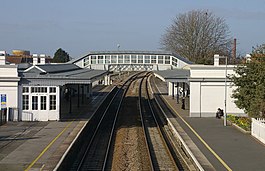Bridgwater railway station
| Bridgwater |
|
|---|---|
 |
|
| Location | |
| Place | Bridgwater |
| Local authority | Sedgemoor, Somerset |
| Coordinates | 51°07′38″N 2°59′30″W / 51.1272°N 2.9917°WCoordinates: 51°07′38″N 2°59′30″W / 51.1272°N 2.9917°W |
| Grid reference | ST307369 |
| Operations | |
| Station code | BWT |
| Managed by | Great Western Railway |
| Number of platforms | 2 |
| DfT category | E |
| Live arrivals/departures, station information and onward connections from National Rail Enquiries |
|
| Annual rail passenger usage* | |
| 2011/12 |
|
| 2012/13 |
|
| 2013/14 |
|
| 2014/15 |
|
| 2015/16 |
|
| History | |
| Original company | Bristol and Exeter Railway |
| Pre-grouping | Great Western Railway |
| Post-grouping | Great Western Railway |
| 1841 | Opened |
| National Rail – UK railway stations | |
| * Annual estimated passenger usage based on sales of tickets in stated financial year(s) which end or originate at Bridgwater from Office of Rail and Road statistics. Methodology may vary year on year. | |
|
|
|
Bridgwater railway station serves Bridgwater in Somerset, England. It is on the Bristol to Taunton Line and is operated by Great Western Railway. Originally built to the designs of Isambard Kingdom Brunel, the station is now a Grade II* listed building.
The railway arrived at Bridgwater on 14 June 1841 when the Bristol and Exeter Railway opened its line. This was the terminus of the line for a year while the Somerset Bridge was constructed over the River Parrett; the line was extended to Taunton on 1 June 1842.
During the period that the station was a terminus it became a focus for horse-drawn coaches that met the trains and carried their passengers onwards. An accident happened when one of these was overturned on the level crossing that was situated at the south end of the platforms, although the only serious injury was a bystander who broke an ankle – the coach driver and passengers were largely unscathed. A hotel was built just outside the station entrance which has since been demolished, but the houses provided for the company's staff can still be seen.
The Bristol and Exeter Railway was initially operated by the Great Western Railway but from 1 May 1849 the company operated its own trains. Coke ovens, to provide fuel for the locomotives, and workshops to build and maintain the carriages and wagons, were built to the west of the line between Bridgwater station and the river – this is the nearest station to the halfway point on the line. They closed following a fire on 25 August 1947, although by this time they were only repairing wagon sheets (i.e. canvas covers). Other local industries linked with the railway were John Browne's Brick and Tile Works, which were owned by a director of the railway and supplied materials to the Great Western and associated companies; and George Hennet's iron works (later Bridgwater Engineering Company) which made track, signals and wagons for several different companies including atmospheric railway pipes for the South Devon Railway Company.
...
Wikipedia
